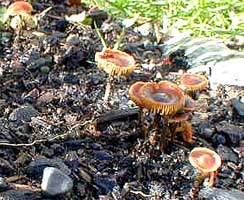
Mushrooms & Fungi
in the Garden
"The mushroom is the elf of plants:
At evening it is not;
At morning in a truffled hut
It stops upon a spot."
-Emily Dickinson
(1830-1886)
(1830-1886)
If anyone can recognize by these photographs at least the genera of these Puget Sound region funguses, do let me know their identities.
Quite a long while back I went on a hike led by the Mycological Society to learn more about our native forest mushrooms, but I'm afraid very little of it "took." I still know next-to-nothing about mushrooms & other fungi, except that I like their varied & strange appearances.
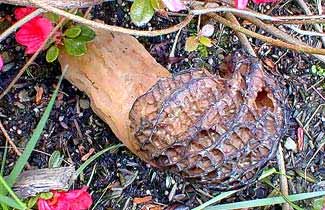 The first photo snapped in March shows wee mushrooms that pop up in the moist organic-rich areas in the gardens. These are very tiny things with slender stems. They start out with classic mushroom caps but as they age, the caps partially turn inside out forming compressed bowls.
The first photo snapped in March shows wee mushrooms that pop up in the moist organic-rich areas in the gardens. These are very tiny things with slender stems. They start out with classic mushroom caps but as they age, the caps partially turn inside out forming compressed bowls.The second photo shot in May is a strange & almost obscene fungus that grew right out of the center of a small shrub that died by summer.
I never knew if the fungus was opportunistic & established itself in dead matter of a shrub that was already doing poorly, or if the fungus was itself the culprit that did the shrub in. To my untrained eye, it resembled a harmless morel mushroom except far larger & not upright.
The shrub had already been showing signs of stress before this huge fungus appeared. Since I didn't know enough about funguses to trust it, I removed & trashed it before it could go to spoor. If I'd had any way to be certain it was harmless, I wouldn't've interferred with it. It was already a foot long when I spotted it!
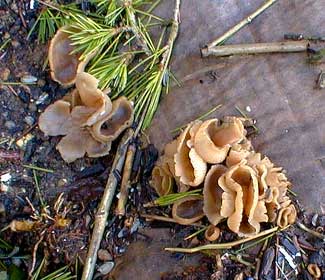 Third photo, snapped in March, is a cup fungus that enjoyed the rotting cardboard that was used as a barrier to smother weeds in advance preparation for an extension to a garden.
Third photo, snapped in March, is a cup fungus that enjoyed the rotting cardboard that was used as a barrier to smother weeds in advance preparation for an extension to a garden.Cup funguses have many genera & species. In general their spoors are wind-dispersed & possibly beetle-dispersed. They are beneficial symbiotic funguses that help plants process soil nutrients.
This same fungus also appeared on a rattan welcome-mat that was in the garden exposed to elements. I several times put off throwing the mat in the garbage, because it was interesting watching the funguses growing on it. But near summer the fungi began to dry out so I finally trashed the old mat.
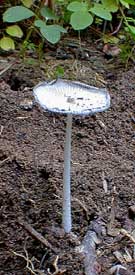 The fourth photo, here at the right, shows a four inch tall skinny white & grey mushroom that appeared in summer in recently turned soil with lots of compost added. I don't know this certainly, but have to assume that many kinds of mushrooms invert their caps in this manner to capture & hold rainwater.
The fourth photo, here at the right, shows a four inch tall skinny white & grey mushroom that appeared in summer in recently turned soil with lots of compost added. I don't know this certainly, but have to assume that many kinds of mushrooms invert their caps in this manner to capture & hold rainwater.The Autumn mushrooms are everywhere as soon as the rains return after the dryness & heat of summer. Often the main part of a fungus is deep under ground.
The visible portion of such mushrooms & toadstools give evidence of healthy fungal activity in the soil, as mushrooms break down dead plant material into humus & nutrients that are good for the plants. For more on the underground activity of funguses whose visible fruits are the smallest portion of the fungus this, see the related article on puffballs.
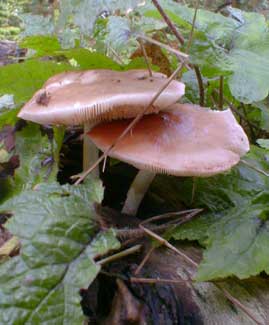 The fifth photo, on the left, shows two mid-sized October mushrooms that erupted on a decorative tree root that sits in a shade garden. This type of mushroom is often spotted in the woods in clusters underneath large trees, apparently attached to roots. My wild guess as to its genus would be Suillus, though I wouldn't bet money on it.
The fifth photo, on the left, shows two mid-sized October mushrooms that erupted on a decorative tree root that sits in a shade garden. This type of mushroom is often spotted in the woods in clusters underneath large trees, apparently attached to roots. My wild guess as to its genus would be Suillus, though I wouldn't bet money on it.These & other funguses come & go in the garden, & are especially numerous toward the end of winter & early spring, then again in autumn. One of my favorites & longest persisting has its own page, the Turkey Tail fungus.
While many gardeners, & especially those who are neurotic about having lawns that look just as boring as astroturf, try to keep mushrooms out of their lawns & gardens, they should really be welcomed & encouraged. Some edible varieties can even be cultivated with great ease right out in the vegetable garden, or amidst ornamentals, specifically for harvest; & the popular Shaggy Mane is said to be easy to establish around a compost pile; Portobellos establish easily in grassy areas among trees; black-gilled Stropharia can be grown wherever the soil has uncomposted wood shavings churned into it; Oyster mushrooms can be grown in woodchip or straw mulch or any number of mediums. Advice on how to get started can be had from your local Mycological Society, who can also provide or lead you to sources for cultures & spawn to get started.
Though I've not yet grown them willfully as harvestable garden ornamentals, I may yet do so, & there's a very active Mycological Society chapter in my county should I make the decision to pursue all possibilities. In the meantime it is thrilling just to observe those which arrive in the garden on their own.